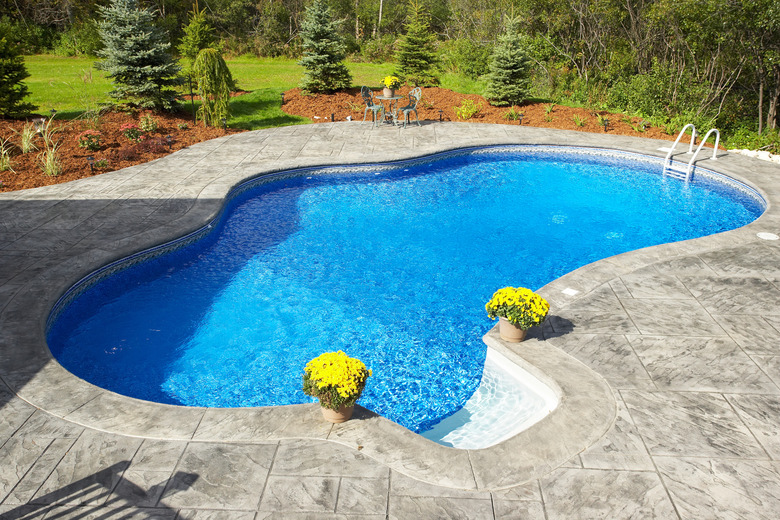How To Refurbish A Gunite Pool
Things Needed
- Pressure washer
- Professional pool cleaning supplies
- Rubber gloves
- Eye protection
- Breathing mask
- Masking tape
- Trowel or putty knife
- Epoxy patch kit
- Latex acrylic bonding agent
- Portland gray cement
- Sand
Gunite is a mixture of sand, concrete and water sprayed on a rebar pool frame. Plaster is then applied to create a waterproof barrier. As gunite swimming pools age, the plaster will occasionally require maintenance and repair. If your home pool has discolorations, stains, cracks, or a rough uneven surface, refurbishing can restore the pool surface to like new condition.
Step 1
Consult a professional pool installation and repair contractor and request a bid on refurbishing your gunite pool. Ask the pool contractor to break the bid down into segments such as draining, cleaning, etching and applying the refurbishing product to the pool and the price of the refurbishing product. Frugal do-it-yourself homeowners may wish to save money and choose to do some, or all of the work, themselves.
- Gunite is a mixture of sand, concrete and water sprayed on a rebar pool frame.
- As gunite swimming pools age, the plaster will occasionally require maintenance and repair.
Step 2
Drain the water away from the pool, using a storm drain if available. Stabilized groundwater by removing the hydrostatic plug at the bottom of the pool drain.
Step 3
Remove or carefully mask and tape all pool fixtures, hardware, light fixtures and machined surfaces.
Step 4
Prep the pool. Prior to refinishing, the surface of a gunite swimming pool must be carefully cleaned and chemically etched. Follow manufacturer's instructions carefully when applying cleaning and etching products. Pool care specialists employ a pressure washer to clean all surfaces of soot, grease and debris. Always wear an OSHA approved breathing mask, rubber gloves and eye protection when applying pool cleaning products or solvents. Be sure that the area is well ventilated.
- Drain the water away from the pool, using a storm drain if available.
- Prior to refinishing, the surface of a gunite swimming pool must be carefully cleaned and chemically etched.
Step 5
A mild solution of trisodium phosphate (TSP) and water can be used to disolve stubborn oil and greases or a diluted solution of muriatic acid can only be used to clean and etch smooth surfaces. Follow manufacturer's package label instructions carefully.
Step 6
Apply a solution of sodium bicarbonate after acid washing. The mixture neutralizes the acid and maintains proper pH balance. Rinse all pool surfaces thoroughly with clear water to remove acidic residue and restore neutrality. Allow the pool surface to dry.
Step 7
Patch and repair all crack, breaks, or holes in the pool surface with an mixture of gray Portland cement sand and a high latex acrylic bonding agent. Use a trowel or putty knife to apply the repair mixture. Fill the hole or crack and smooth the surface. Allow repairs to dry for a minimum of 24 hours.
- A mild solution of trisodium phosphate (TSP) and water can be used to disolve stubborn oil and greases or a diluted solution of muriatic acid can only be used to clean and etch smooth surfaces.
- Apply a solution of sodium bicarbonate after acid washing.
Step 8
Sand repaired areas smooth so that they will not show through the refurbishing coating. Reseal all lighting fixtures and hardware with an epoxy patch kit, following application instructions.
Step 9
Apply the elbow grease and lean, clean and clean some more. All pool surfaces must be free of dust, dirt, grease, oil or other surface contaminants. Allow pool surface to dry completely before proceeding.
Step 10
Paint the pool with an epoxy paint following the coverage chart on the product packaging or choose one of the new plaster products such as "Diamond Brite". Plaster can be tinted any color and plastered on by spray or application or with a trowel. Properly applied, the finish will last up to ten years.
- Sand repaired areas smooth so that they will not show through the refurbishing coating.
